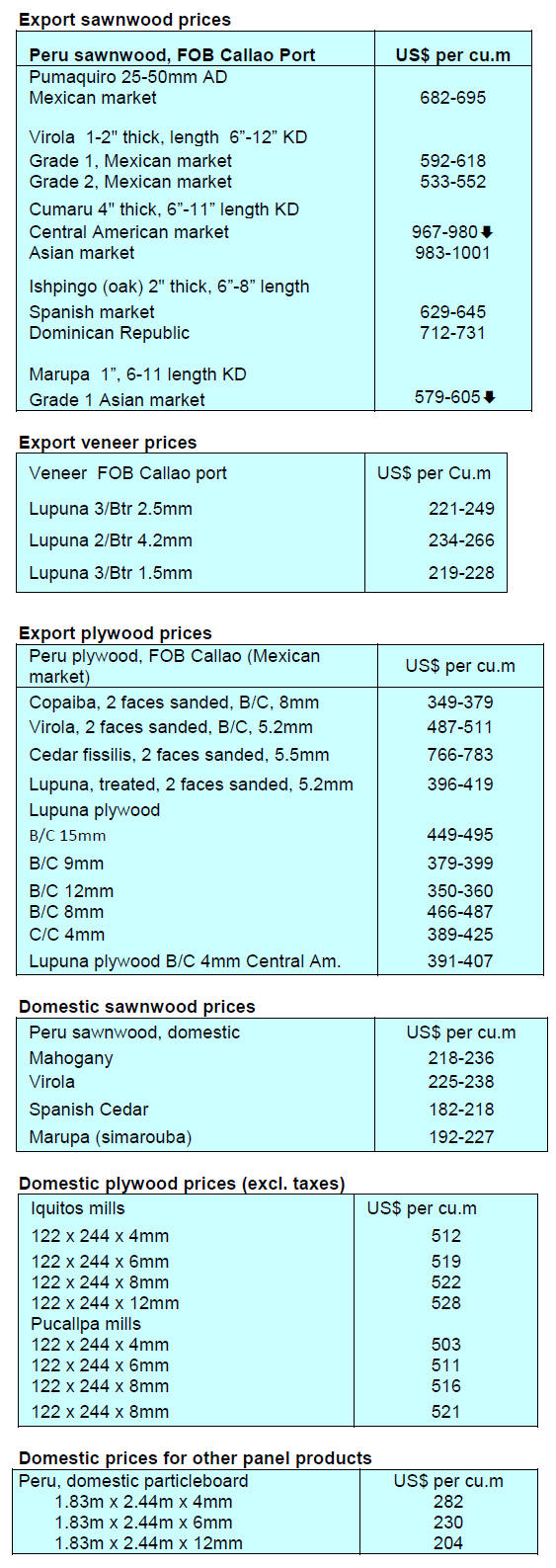4.
INDONESIA
Export benchmark prices - Merbau sawnwood
price increased by US$300
The Ministry of Trade has published its Timber Export Benchmark
Price List (HPE) for timber for the period 1-31 May 2023.
For veneer raw material from plantation forests and processed wood products
from mixed forest prices have been lowered by US$50/cu.m from the previous
month. However, veneer products from plantation logs for wooden sheets for
packing boxes have increased.
The following is a list of Timber HPE for the period 1-31 May 2023.
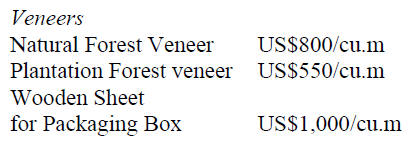

Processed Wood
Processed wood products which are leveled on all four sides so that the
surface becomes even and smooth with the provisions of a cross-sectional
area of 1000 mm2 to 4000 mm2 (ex 4407.11.00 to ex 4407.99.90
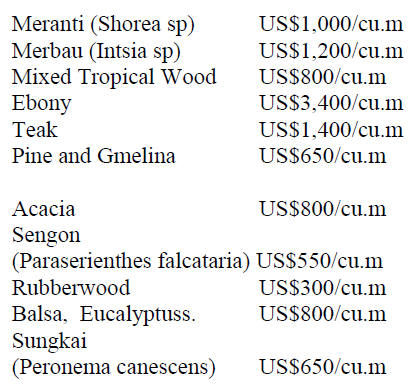
Processed wood product which is leveled on all four
sides so that the surface becomes even and smooth from Merbau wood (Intsia
sp) with a cross-sectional area of more than 4000 sq.mm to 10000sq. mm (ex
4407.29.91 and ex 4407.29.92): US$1,500/cu.m
See:
https://forestinsights.id/2023/05/02/kemendag-tetapkan-harga-patokan-ekspor-hpe-kayu-mei-2023-kayu-gergajian-merbau-melonjak-300-dolar-as/
Risk to timber by US debt default
The wood and furniture industries are vulnerable to being affected by a
default in the United States. The Executive Director of the Institute for
Development of Economics and Finance (Indef), Tauhid Ahmad, said the wood
and wood products, furniture, electricity, footwear, rubber and rubber
product industries are strategic export industries and the performance of
these industries has contributed to the national economy.
He suggested that if the US debt default situation drags it may result in a
recession which would affect Indonesia's economic growth.
See:
https://forestinsights.id/2023/05/08/industri-kayu-dan-furnitur-rawan-terdampak-gagal-bayar-utang-amerika-serikat/
Could EUDR strengthen competitiveness of wood products from
Indonesia?
Timber is one of the products under the European Union's regulation on
deforestation-free supply chains (EUDR) and this will have an impact on
Indonesian wood product exports to the EU. Muhammad Ichwan, the Executive
Director of the Independent Forestry Monitoring Network (JPIK), said that,
until now, there has been no detailed technical guidance regarding the EUDR.
However, he suggested the EUDR could strengthen the competitiveness of wood
products from Indonesia. He commented “although it (EUDR) regulates the
prohibition of products resulting from deforestation from entering the EU
this regulation will not hinder the timber trade as long as these wood
products do not result in deforestation.”
The domestic media commeneds that Ichwan believes implementation of EUDR
could strengthen Indonesia's Timber Legality Verification System (SVLK) as a
more moderate market instrument. However, Ichwan said that the EUDR could
also become an additional burden for timber businesses.
See:
https://www.kompas.id/baca/humaniora/2023/05/03/daya-tawar-produk-kayu-asal-indonesia-dapat-diperkuat
Human resources to boost competitiveness of furniture Industry
The Ministry of Industry has noted the furniture industry is a
significant contributor to national economic growth with export earnings of
around US$2.5 billion in 2022. The workforce in the sector is said to be
around 145,000 in 1,114 companies. In order to increase the productivity and
competitiveness of the furniture industry the Ministry of Industry plays a
role in creating skilled human resources.
The Head of the Industrial Human Resources Development Agency (BPSDMI) in
the Ministry of Industry, Masrokhan, has pointed out that one of the
vocational education units managed by the Ministry of Industry is the
Furniture Industry and Wood Processing Polytechnic (Polifurneka) in Kendal,
Central Java which has been able to produce competent human resources in the
field of furniture and wood processing.
Masrokhan explained "the purpose of establishing this polytechnic is to
encourage further investment in the industrial sector through the provision
of trained industrial workers in the furniture sector, empowering human
resources in the Semarang-Kendal region, as well as a providing a center for
innovation for the furniture and wood processing industries".
See:
https://www.viva.co.id/siaran-pers/1597221-kemenperin-sdm-kompeten-pacu-investasi-dan-daya-saing-industri-furnitur
Encouraging investment in agarwood plantations
The Chairman of the Central Leadership Council of the Indonesian
Gaharu Farmers and Entrepreneurs Union (SPPGI), Syamsu Alam, has encouraged
the community to increase establishment of agarwood plantations.
He stated that agarwood has been exported to more than 139 countries
including Europe, America, the Middle East and Asia where it is used for
making perfumes and herbal medicines.
He said natural agarwood from Papua is one of the best because it grows
naturally while most agarwood grows in plantations. Naturally grown agarwood
commands the best price and is mainly from Papua and Kalimantan. He added
“there are not enough farmers who focus on producing and that the SPPGI is
ready to provide assistance on growing agarwood.
See:
https://en.antaranews.com/news/280038/sppgi-encourages-increased-production-of-agarwood-plantations
Foreign entities can buy carbon credits in Jakarta
The government has decided to allow foreign entities to purchase
credits in the Indonesian carbon market, paving the way for multinational
companies and institutions to tap into the country’s large carbon trading
potential.
The announcement came after the Minister for Investment, Bahlil Lahadalia,
met with the President. The Minister stressed that all entities
participating in carbon-trading activities in the country should be
registered with the national registry system (SRN) and the transaction
process should be through the country’s carbon exchange.
See:
https://asianews.network/indonesian-govt-allows-foreign-entities-to-buy-carbon-credits-from-jakarta/
Indonesia economic growth keeps pace ahead of expected slowdown
In the first quarter of this year Indonesia's economic growth was
maintained but a slowdown, triggered by weakening exports and high-interest
rates, is likely. Indonesia’s economy expanded 5.03% in the first quarter,
slightly up from 5.01% in the previous quarter. First quarter growth was
driven by household spending, metal and mineral exports and tourism.
See:
https://www.thejakartapost.com/business/2023/05/05/indonesia-economic-growth-keeps-pace-ahead-of-expected-slowdown.html
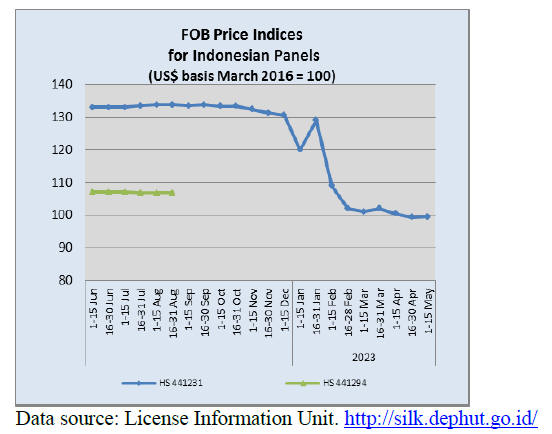
5.
MYANMAR
Timber exports reported
At the end of the financial year 2022-23 (1 Apr. 2022 to 31 Mar.
2023) exports of timber earned US$140 million according to the Department of
Trade. Myanmar exported US$154 million in 2019-20 and US$128 million in
2020-2021.
It is widely expected that exports will decline in fiscal 2023-24 since
importers in the EU and USA have almost stopped buying Myanmar teak. The
Myanma Timber Enterprise (MTE) sold, by tender, 1,500 tons of teak logs and
1,000 tons of other hardwood logs on 11 May.
See:http://www.mte.com.mm/index.php/en/27-tenders/export-milling-marketing-dept-tender/teak-logs/1472-tender-announcements-of-11th-may-2023)
Border trade expanding
Myanmar’s border trade with the Thailand totalled US$393 million in
April this year surging from US$329 million in April last year.
The Myanmar/Thai border trade is via Tachilek, Myawady, Kawthoung, Myeik,
Hteekhee and Mawtaung border crossings. Among them, the Hteekhee border
crossing saw the most traffic worth US$273 million in April.
Myanmar also conducts border trade with China, Bangladesh and India and
exports mainly agricultural products while importing capital goods,
intermediate goods, consumer goods and raw materials.
See:
https://www.gnlm.com.mm/myanmar-thailand-border-trade-crosses-us390-mln-in-april-2023-2024/
ASEAN leaders’ statement on the recent attack on aid convoy
In early May a convoy delivering aid to displaced villagers in
Myanmar and carrying Indonesian and Singaporean diplomats came under fire by
unidentified men armed when travelling in Myanmar’s eastern Shan State. A
security team with the convoy returned fire and a vehicle was damaged but no
one in the convoy was injured. Indonesia, which serves as ASEAN’s chair this
year, had arranged for the delivery of aid.
A statement from the ASEAN Secretariat reads “We were deeply concerned with
ongoing violence in Myanmar and urged the immediate cessation of all forms
of violence and the use of force to create a conducive environment for the
safe and timely delivery of humanitarian assistance and inclusive national
dialogues.
We support the statement of the President of the Republic of Indonesia as
the Chair of ASEAN on 8 May 2023 in response to the recent attack on a
convoy of the AHA Center and the ASEAN Monitoring Team in Myanmar.
We condemned the attack and underlined that the perpetrators must be held
accountable. We supported the efforts of the Chair of ASEAN, including its
continued engagements with all stakeholders in Myanmar, to encourage
progress in the implementation of the Five-Point Consensus.”
See:
https://asean.org/wp-content/uploads/2023/05/STATEMENT-FINAL-RELEASE.pdf
6.
INDIA
Real Estate sentiment index dips
The January-March 2023 Real Estate Sentiment Index published by the
real estate consultant, Knight Frank and the National Real Estate
Development Council (NAREDCO) indicates that current sentiment, while
remaining positive, has weakened recently.
See:
https://www.knightfrank.com/research/report-library/real-estate-sentiment-index-q1-january-march-2023-10154.aspx
Manufacturers raise plywood prices
Plywood Manufacturers in North India have decided to raise plywood
prices citing raw material supply and price issues. These manufacturers also
decided to cut production by closing mills for two days a week in an effort
to spur demand and drive up prices.
On raw material supply the president of North India Plywood Manufacturers
Association said that as there has been active plantation establishement in
recent years and he is hopeful the supply issue will be overcome in next 3
to 4 years. However, plymills now have to compete for raw materials with new
MDF and particleboard mills.
See:
https://plyinsight.com/curtailing-production-in-the-plywood-sector-will-be-decisive/
April 2023 issue
MDF production increasing
Plyreporter has said the construction and furniture sectors in
India are booming with many new production lines coming on-stream. This has
driven up demand for particleboard and MDF.
Plyreporter says demand for MDF is good and is growing at between 35-40%
annually. The trade journal also said particleboard production capacity is
forecast to rise 20% in 2023. 2022 was excellent for the particleboard
industry with rising demand mainly from ready-made furniture manufacturers.
See:
https://www.plyreporter.com/MDF-particle-board/market-buzz

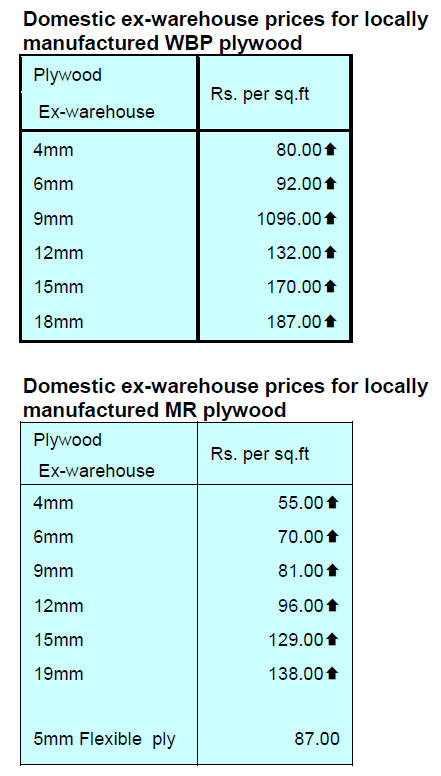
JICA loan for forestry
On behalf of Japan, JICA signed a loan agreement with the
Government of India to provide loans of up to a total of Yen 426,814 million
for four projects, one of which is for Forest and Biodiversity Conservation
for Climate Change Response in West Bengal.
The object of this forestry project is to mitigate and adapt to climate
change, conserve, and restore ecosystems by ecosystem-based climate change
measures, biodiversity conservation and restoration, livelihood improvement
activities and institutional strengthening thereby contributing to
sustainable socio-economic development in West Bengal. The Executing Agency
will be the Department of Forests, Government of West Bengal.
See:
https://www.jica.go.jp/english/news/press/2022/20230329_33.html
7.
VIETNAM
Wood and Wood Product (W&WP) trade
highlights
The Department of Customs has reported W&WP exports to the US
market in April 2023 were valued at US$584 million, down 38% compared to
April 2022. In the first 4 months of 2023 W&WP exports to the US market are
estimated at US$1.97 billion, down 41% over the same period in 2022. W&WP
exports to Canada in April 2023 were recorded at US$16.3 million, down 32%
compared to April 2022.
In the first 4 months of 2023 W&WP exports to the
Canadian market are estimated at US$57.6 million, down 35.7% over the same
period in 2022.
Exports of bedroom and dining room furniture in April 2023 are estimated at
US$184.1 million, down 39% compared to April 2022. In the first 4 months of
2023 exports of bedroom and dining room furniture amounted to US$623
million, down 44% over the same period in 2022.
Vietnam's imports of oak wood in April 2023 are estimated at 27,300 cu.m,
worth US$14.8 million, up 3.2% in volume and 3.1% in value compared to March
2023.
Compared to April 2022, imports increased by 18% in volume and 15% in value.
In the first 4 months of 2023 oak imports are estimated at 79,100 cu.m,
worth US$43.8 million, up 6.4% in volume but down 0.6% in value over the
same period in 2022.
Imports of logs and sawnwood (raw wood) from the EU to Vietnam in April 2023
showed a third consecutive month of increase, reaching 58,000 cu.m at a
value of US$18.0 million, up 11% in volume and 13% in value compared to
March 2023; but down 14% in volume and 20% in value compared to April 2022.
In the first 4 months of 2023, imports of raw wood from the EU was recorded
at 192,310 cu.m at a value of US$58.82 million, down 17% in volume and 20%
in value over the same period in 2022.
Exports of office furniture gloomy
Of office furniture, tables and cabinets are the 2 main items
topping exports. In the first 3 months of 2023 exports of these 2 items
accounts for 77% of the total export value of office furniture.
Vietnam's office furniture exports in April 2023 were valued at US$23
million, down 27% compared to April 2022. In the first 4 months of 2023
office furniture exports reached US$86.3 million, down 32% over the same
period in 2022.
In the first 4 months of 2023, W&WP imports accounted for US$665 million,
down 30.3% over the same period in 2022.
Leading the exports was tables with an export value of US$22.3 million, down
36% over the same period in 2022. Table products were exported mainly to the
US market in the first 3 months of 2023, reaching US$12 million, down 42%
over the same period in 2022; followed by Japan, China and the EU.
Exports of cabinets in the first 3 months of 2023 reached US$21.1 million,
down 44% over the same period in 2022 and accounted for 38% of total export
earnings from office furniture. Cabinet products are exported mostly to the
US, Japan and the UK.
In addition, in the first 3 months of 2023 other office furniture export
items included desks, bookshelves, chairs, study desks and computer desks.
Notably, exports of office chairs recorded a high growth in the first 3
months of 2023, reaching US$1.6 million, up over 200% over the same period
in 2022.
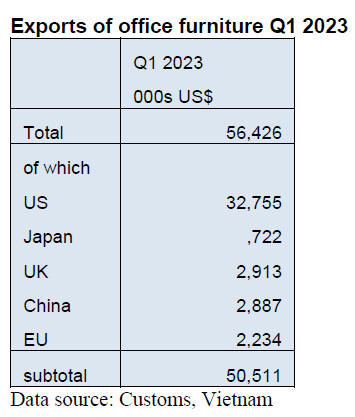
Exports of living and dining room furniture
As the global economy slows demand for living and dining room
furniture in the major markets such as the US, EU, UK and Japan has
weakened. Accordingly, exports turnover of this WP category continue are set
to decline further in the coming months.
Vietnamese manufacturers are being encouraged to expand and diversify export
markets, explore new and potential markets, such as India, Africa, the
Middle East and Latin America, Eastern Europe. At the same time, they should
attempt to promote the effective utilization of free trade agreements
Vietnam has concluded to promote this industry in the coming time.
Along with wekening international demand the reopening of China has also
created additional competitive pressure on the wood product industry,
especially Vietnam's furniture sector as China is still the world's largest
exporter of wooden furniture.
The Vietnam Timber and Forest Products Association (Viforest) forecasts
that, with the current growth rate exports of wood and wood products in the
first half of 2023 will fall by around 30% over the same period last year.
However, opportunities are still available if wood businesses seek to expand
markets and improve competitiveness, focusing on product price criteria in
Vietnam at reasonable levels for consumers, products following tastes,
quality products, and good after-sales policy.
Along with that is restructuring and reorganising the production of
enterprises, focusing on technological innovation, perfecting the production
management system and improving the efficiency and quality of human
resources.
The sector has been advised to step up production using domestic raw
materials to reduce costs.
Faced with great difficulties in the market due to highglobal inflation,
Vietnam's exports of wood and wood products are falling sharply. Vietnam's
wood industrystrives to find new markets. The fact shows that in the past
time, the Vietnamese wood industry has been trying to find and expand to new
and potential markets such as India, and the Middle East.
At the end of April, more than 50 Vietnamese furniture enterprises joined
together the webinar "Indian furniture export market: Market size and export
potential", organised by the Handicraft and Woodworking Association of Ho
Chi Minh City (HAWA).
In 2022 the Indian furniture market was worth US$23.12 billion and is
predicted to grow at a CAGR of 11% from 2023 to 2028. The size and demand of
the furniture market are increasing, and India is considered a potential new
market for Vietnamese furniture exporters.
See:https://vietnamagriculture.nongnghiep.vn/vietnams-woodindustry-strives-to-find-new-markets-d350081.html
Imports of padouk from Africa
Vietnam's imports of padouk from African sources accounted for 89%
of total imports of this highly valued timber from all sources in the first
3 months of 2023 reaching 32,800 cu.m, worth US$10.1 million, up 3.5% in
volume and 8.2% in value over the same period in 2022.
Of which imports from Angola increased by 197%; Namibia rose by 5%;
Equatorial Guinea increased by 264% and Mozambique by over 2,000%
year-on-year.
In contrast, imports from Laos decreased by 59.7% in volume and 63.3% in
value over the same period in 2022, reaching 2.4 thousand cu.m, worth US$2.5
million, accounting for 6.5% of total imports.
Padouk sawn wood and log imports
In the first 3 months of 2023 imports of sawn padouk totalled
32,500 cu.m, worth US$11.8 million, down 8% in volume and 23% in value over
the same period in 2022.
At the same time, padouk log imports reached 4,4000
cu.m worth US$1.5 million, down 8% in volume and 15% in value over the same
period in 2022.
Padouk price fluctuations
The average import price for padouk wood in the first 3 months of
2023 stood at US$362/cu.m, down 16% over the same period in 2022. Imports of
padouk from Laos fell 9.0% year on year in the first quarter US$1,051/cu.m;prices
from Thailand fell 17% to US$475/cu.m; Papua New Guinea down 1% to US$330.0/cu.m.
Padouk suppliers
In the first 3 months of 2023,the volume of padouk imported into
Vietnam from Africa and Thailand increased compared to the same period in
2022 while imports from Laos, Hong Kong, Papua New Guinea, China dropped.
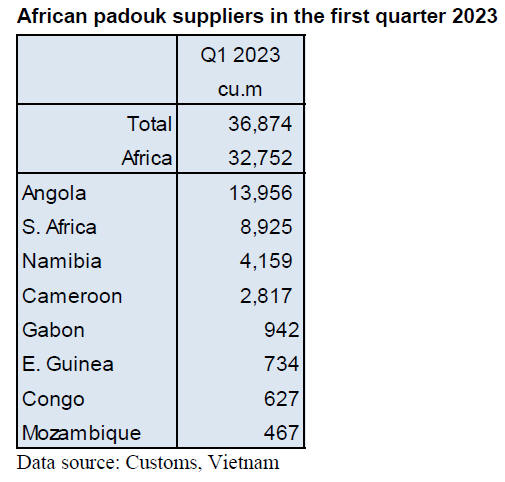
8. BRAZIL
Furniture sector alerted on EUDR
The Brazilian furniture sector has been alerted to the risks
to businesses from the recent European Union regulation
that prohibits its member countries importing wood
products unless it can be shown that the raw materialused
in manufacture did not come from forests that were
deforested or degraded.
When the regulation is implemented exporters need to
present certificates proving the origin of the raw material
including GPS coordinates and the guarantees of respect
for human rights, especially those of indigenous people.
Against this background ABIMÓVEL (Brazilian
Association of Furniture Industries) stressed the need for
certification of raw materials and production processes in
the Brazilian furniture industry. The adoption of certified
wood from sustainable forest management is already an
obligation within the sector. With more than 20,000 native
timber species in natural forests Brazilian tropical timber
has an important place in the furniture sector.
See:
https://forestnews.com.br/setor-moveleiro-industrias-leiuniao-europeia/
Prospects for the forest-based sector in Rondônia
Representatives of the private sector, public authorities
and NGOs recently gathered in Rondônia, to discuss the
current and future prospects for production forests in the
state. Rondônia is the third largest wood producing state in
the Amazon region.
The event "Rondônia's Forest Sector: opportunities for
sectoral planning" was organised by the Institute of Forest
and Agricultural Management and Certification
(Imaflora).
During the meeting, the study "Evolution of the forestbased
industry in Rondônia and opportunities for sectoral
planning and for the conservation of production forests",
published by Imaflora, was launched.
This is a comprehensive study on the development of
the forest sectory in Rondônia State which seeks to shed light on sector
dynamics, identify the main bottlenecks and present perspectives and
development opportunities.
Among the main recommendations was creating a territorial plan for Rondônia
State as a solution to further development of responsible forest management
in large production forests located in public land areas through forest
concessions and community forest management. The event was successful in
that it brought together the main relevant players in the timber sector in
the state for a discussion on the challenges that are posed to the
sustainability of the forest-based industry in the long term.
See:
https://www.imaflora.org/noticia/rondonia-o-terceiro-maior-produtor-de-madeira-da-regiao-amazonica-recebeu-evento-para-debater-o-cenario-atual-e-perspectivas-para-o-setor-de-base-florestal
Teak wood shipped from Port of Outeiro
The Atlântica Matapi Group, a company specialised in logistics in
the Amazon, made its first shipment of teak (Tectona grandis) logs produced
in forest plantations. A total of 11,500 tonnes of wood were shipped to
India. The teak shipped is from plantations, which can take 25 to 30 years
to reach the ideal age of harvesting, is widely used in Asia.
The shipment departed the Port of Outeiro, Belém Municipality, in the state
of Pará one of the main tropical timber producing states in the Amazon
Region. According to Matapi, the advantages of this port are quick vessel
turn round and competitive costs.
The partnership between Matapi and a major teak producing company in the
region gained strength in 2023. In the coming months fifteen export
shipments are planned which may total about 200,000 tonnes of teak..
See:
https://www.portosenavios.com.br/noticias/portos-e-logistica/matapi-embarca-teca-de-madeira-no-porto-de-outeiro
Timber exports drop in the first quarter of the year
Timber exports from the State of Pará, in the Amazon Region ended
the first quarter of this year lower than in the same period last year. In
total, export sales were worth US$57.3 million in the first quarter, down
47% year on year despite a 2% increase in the volume shipped.
See:
https://www.portalsantarem.com.br/noticias/conteudo/exportacoes-de-madeira-fecham-1-trimestre-em-queda/135219
Overall export prices suffered a strong retraction and closed March with an
average of US$804 per tonne, which represented a 36% drop in relation to the
previous month according to AIMEX (Association of Timber Exporting
Industries in the State of Pará).
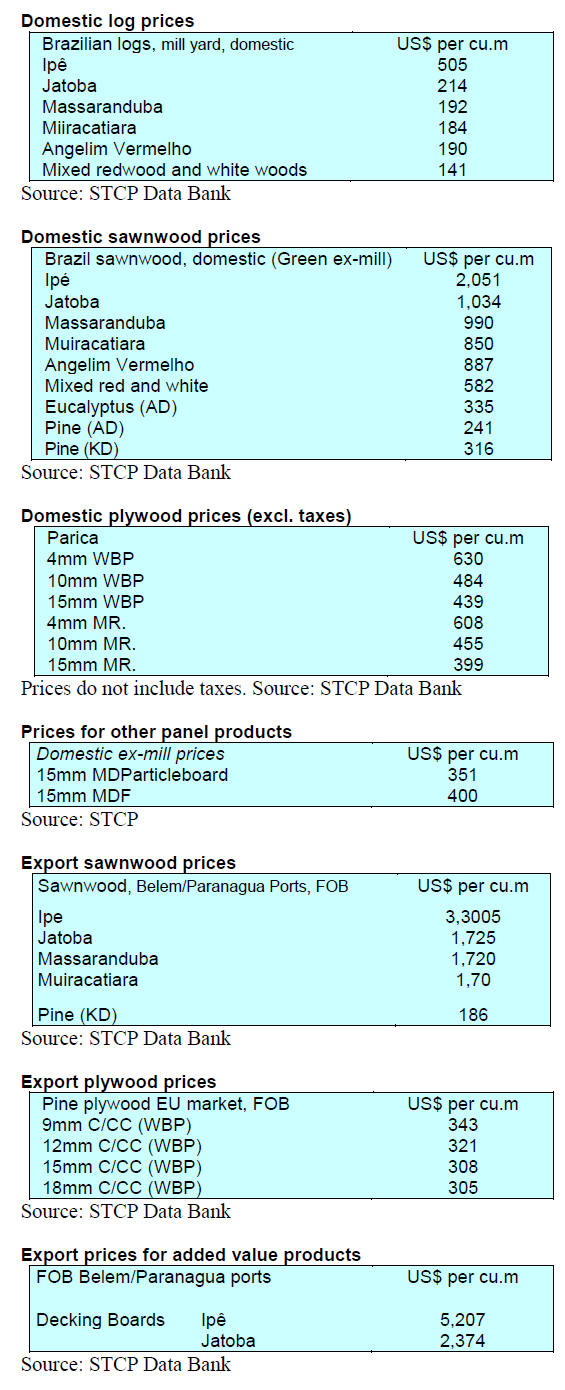
9. PERU
Timber fair in Pucallpa City
The company, Tropical Forest, in cooperation with the Regional
Government of Ucayali, the Regional Directorate of Production of Ucayali and
the National University of Ucayali will hold a timber fair ‘Tecno Forestal
Ucayali’ for the forestry and forest industry sectors.
This fair had been held in the past and now the
organisers are relaunching it for September 14 and 15, 2023 and hope to
present a wide range of processing machinery for the first and second
transformation of wood.
Communities coached on negotiating fair harvesting agreements
It has been reported by the Agency for the Supervision of Forest
Resources and Wildlife (OSINFOR) that leaders and representatives of 38
native communities in the regions of Ucayali, Pasco and Loreto strengthened
their capacity to achieve fair treatment, within the framework of the law,
with third parties in order to ensure they can take advantage of sustainable
harvesting in forests under their care.
The trainers traveled to the provinces of Coronel Portillo (Ucayali),
Oxapampa (Pasco) and Mariscal Ramón Castilla (Loreto) to conduct three
face-to-face workshops with the communities.
The first workshops were held in April in Pucallpa and Puerto Bermúdez,
Oxapampa. The final workshop was held in the town of Pebas, Loreto. The
topics discussed were community forest management and negotiation and
agreements with third parties.
Exchanging data on the forestry sector
In order to optimise the exchange of data between forest sector
stakeholders the Organismo de Supervisión de los Recursos Forestales y de
Fauna Silvestre (OSINFOR) provided technical assistance to forestry
professionals from Ucayali on the use of the SIADO Region, a system that
allows to regional authorities to share data on management plans
facilitating decision-making and supervision planning.
Use of the system allowed Ucayali, Loreto and Madre de Dios to meet the
deadline date for submission of management plans.

